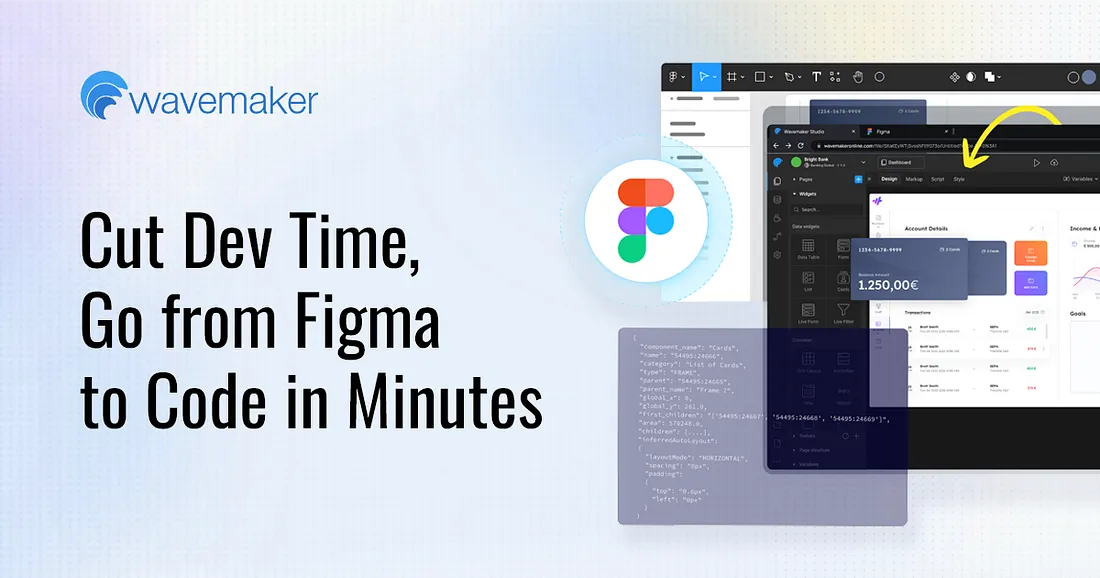In this blog, read about our Figma plugin - WaveMaker AutoCode, that delivers a pixel-perfect translation of design to code, always landing an accurate, enterprise-grade output. Learn how AutoCode does it all.

Converting Figma designs into application code requires an understanding of what designers intend, not just what they draw. While design tools like Figma excel at collaboration, the path from design to working applications typically involves multiple tools and manual translation. WaveMaker AutoCode eliminates this complexity through integrated design-to-code translation that actually works.

Traditional design handoff workflows assume that developers will manually recreate interfaces, making architectural decisions based on their interpretation of static designs. Even specialized tools solve only part of the puzzle, creating tool fragmentation requiring teams to manage designs across different platforms, each with its own learning curve and limitations.
The fundamental issue is not visual accuracy — it is the structural understanding. Figma designs contain visual positioning but lack the functional relationships developers need. Two buttons sitting side-by-side might be independent elements, part of a toolbar, or components of a larger form. Without understanding these relationships, automated tools will generate layouts that look like “random colorful squares across the page” rather than coherent interfaces.
Real-World Example: A dashboard with three metric cards displayed horizontally could be interpreted as three separate components or as a structured data visualization. The visual appearance is identical, but the functional implementation is completely different. Independent components might stack unpredictably on mobile devices, while a proper row structure maintains the intended layout across screen sizes.
This structural ambiguity forces developers to spend weeks reverse-engineering design intent, often getting it wrong and requiring multiple iterations to match what the designers originally envisioned.
WaveMaker AutoCode uses a machine learning model built on FastText to analyze component relationships that Figma’s metadata does not capture. Unlike simple visual scanners that only read positioning data, this ML model understands context and infers structural meaning through sophisticated pattern recognition.
Example: When the model encounters a contact form with name, email, phone, and message fields arranged vertically, it recognizes these as related form elements rather than independent text inputs. The generated code includes proper form validation, a responsive layout, and submission handling, rather than four separate input components.
This contextual understanding transforms raw visual information into the structured data that enterprise-grade applications require, ensuring that the output reflects actual user intent rather than just visual positioning.
Integration with WaveMaker’s foundation CSS and style dictionary system is what WaveMaker AutoCode’s innovation is about. This token-based approach fundamentally changes how design systems translate into maintainable code.
Every visual property in WaveMaker applications maps to specific design tokens that can be modified systematically:
Practical Implementation: A primary button uses tokens like — color-primary-500 for background, — color-white for text, and — radius-md for corner rounding. When rebranding requires changing from blue to green, updating one token instantly transforms every primary button throughout the application.
Corporate Integration: A healthcare company with strict accessibility requirements can configure tokens to ensure all colors meet WCAG contrast standards, all touch targets meet minimum size requirements, and all typography follows their approved hierarchy. Companies managing multiple product lines can maintain separate token sets while sharing the same component library, ensuring brand consistency within each product while enabling distinct visual identities.
This systematic approach solves the classic developer complaint: they want to focus on functionality and data connections, not writing CSS for every interface element.
Unlike traditional workflows that force teams to manage multiple specialized platforms, WaveMaker AutoCode works within a complete development environment:
This integration maintains design fidelity while enabling immediate backend connectivity, responsive behavior, and enterprise-grade architecture without requiring teams to master multiple platforms.
Structural Accuracy and Production Architecture:
By understanding component relationships rather than just copying visual positions, WaveMaker AutoCode generates layouts that behave correctly across different contexts:
Responsive Behavior: A mobile navigation that properly adapts to tablet and desktop viewports, maintaining usability rather than just scaling visual elements.
Enterprise Features: Generated applications include authentication integration, internationalization support, API connectivity, and deployment pipeline integration from day one.
Accessibility Compliance: Form structures that automatically include proper labeling, tab order, and screen reader support.
Example: An insurance company’s customer portal generated through AutoCode includes role-based access control, encrypted data handling, and compliance logging without additional configuration.
Teams can start adding business logic and API integrations immediately instead of spending weeks recreating interface elements. Applications remain adaptable throughout their lifecycle, with design changes propagating through token updates rather than code rewrites.
Backend Integration: Connect forms to existing databases and APIs through WaveMaker’s CoPilot assistant.
Iterative Refinement: An e-commerce platform can test different checkout interfaces by adjusting spacing tokens, color schemes, and component arrangements without rebuilding functionality.
Brand Evolution: Marketing teams can implement new brand guidelines across all applications by updating design tokens rather than requesting development cycles.
Performance Optimization: Teams can modify component rendering and interaction patterns based on user feedback without affecting business logic or data integration.
WaveMaker AutoCode isn’t just faster design-to-code translation — it’s integrated design-to-deployment within a unified platform.
Teams get:
For teams tired of juggling multiple platforms and manually translating designs into code, WaveMaker AutoCode delivers the seamless workflow that rapid application development requires.
The combination of intelligent analysis, systematic styling, and integrated development creates an experience within which design fidelity and development velocity finally work together rather than against each other.